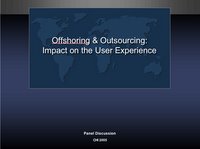"Today, I think of offshoring as a non-issue. There's no point in lobbying against it, in writing letters to Congress or Parliament, much less to business executives. It's a done deal, a fact of life. Deal with it."
 At CHI 2005, I moderated a panel entitled, ("Outsourcing and Offshoring: Impact and Consequences for the User Experience." Panelists discussed issues such as the impact of:
At CHI 2005, I moderated a panel entitled, ("Outsourcing and Offshoring: Impact and Consequences for the User Experience." Panelists discussed issues such as the impact of:- time, language, and cultural differences;
- the nature and level of process development;
- infrastructure (both electronic and physical);
- location of users relative to offshore teams;
- level of training and expertise offshore; and
- characteristics of the work being offshored.
As SIGCHI's Local Chapters Chair for 5 years, I somewhat unknowingly helped make offshoring of user experience work a fact of life, working with people around the world to help them set up and successfully lead and manage regional and national HCI communities. Countries in which I helped establish and grow SIGCHI chapters included India, Russia, Romania, Brazil, Korea, South Africa, Poland, Mexico, Czech Republic, Israel, Chile, New Zealand, and Bulgaria, many of which are identified in a January 2006 issue of BusinessWeek as countries competing for offshore outsourcing by U.S. and Western European companies.
For those 5 years, I worked with (prospective) chapter leaders from long range as well as face-to-face, bringing many of these leaders together for annual workshops. I wrote and edited numerous articles to help (prospective) chapter leaders in all locations; articles included:
- Shaping the Roles to be Played During the 21st Century by Local Chapters of ACM SIGCHI, an article about the workshop for which I brought together leaders of 27 chapters from 18 countries;
- How New Local Chapters Work: The Experience of Czech SIGCHI, an article by Pavel Slavik and Boba Mannova about Czech SIGCHI's first two years and its plans for the future; and
- Diversity Within Unity: The Purpose of a Local SIG, about variations in chapter purpose and approach around the world.
Now, I'm a member of the Executive Council of the User Experience network (UXnet) which has Local Ambassadors in a rapidly increasing number of countries (25, I believe, as I write this) working to foster the growth of user experience communities and to facilitate networking among them (see UXnet Local Ambassadors: Building a Global Community One Locale at a Time). And I'm presently interacting with people in Asia and elsewhere to make UXnet's Advisory Board international.
I have also led expansion of user experience capability outside of the U.S. within businesses which have employed me, working with and within offices in multiple countries to develop and promote their user experience practice. I have hired, managed, coached, and advised individuals and teams in these offices, and worked to improve working relationships of user experience personnel with others within as well as across geographic boundaries.
I am very proud of all of this work, and I've delighted in getting to know and work with so many people around the world, traveling to Italy, France, Netherlands, India, Australia, Germany, U.K., Austria, and elsewhere to make it happen. Indeed, I hope much more work and travel of a related nature lies ahead for me.
Last November, I visited Microsoft Research Asia in Beijing to learn more about Neema Moraveji's exploration of issues of designing for the Chinese. As I stated in a recent blog entry:
"Great dividends await those companies who put ample resources in understanding the culture and living patterns of emerging markets, and in applying that understanding to identifying new opportunities for design for user experience."Presently, I'm learning Mandarin via podcasts. I would have benefited from such learning when in Beijing last year, though I was able to get by reasonably well as the use of the English language in China is increasing. However, knowing more Mandarin than I did is important.
Offshore, and the offshoring of, user experience work is a reality that will increasingly affect us all.
